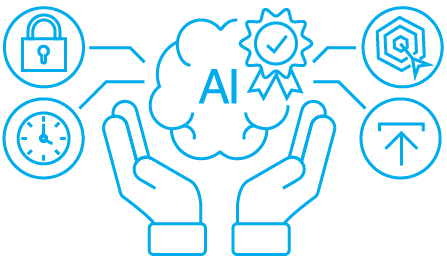- MAIDs - reaching users on mobile devices
- What is a Mobile Ad ID?
- How MAID is used in advertising?
- MAID audiences - mobile target groups based on IDs
- Mobile Ad ID vs a cookie
- Mobile Ad ID and data privacy
- Mobile IDs in programmatic campaigns - use cases
- Reach mobile audiences successfully
In 2025 96.3% of internet users access the internet using a mobile phone. What’s more, people using mobile devices contribute to 64.35% of all website traffic. These numbers highlights the opportunity for implementing an effective mobile advertising strategy based on Mobile Ad ID (MAIDs) or mobile browser data.
Mobile IDs: A Key to Precise Audience Targeting
MAIDs – reaching users on mobile devices
Your mobile targeting campaign can reach users at the same time from the browser and application level, or separately with mobile audience data. The most popular and profitable mobile channels currently (mobile browser and in-app) take data from different sources – a well-known cookie file tracks browser behavior and a MAID – application use.

The digital advertising industry sees a couple of good benefits that MAIDs brings: thanks to mobile user identification and tracking functions they have a complete picture of the mobile target audiences to drive towards better personalization and higher ROI.
What is a Mobile Ad ID?
MAID is a sequence of random symbols, and it’s generated by the mobile device’s operating system. It’s shared with the servers of the apps to track users’ customer journey and “remember” his or her choices.
You can find MAID within privacy settings and you can limit or reset it. This action is similar to clearing the browser cookies from the very beginning and starting history over.

There are two popular names of MAIDs, and they are connected to mobile operating systems on users’ devices, and advertisers can use IDs to target ads, such as google ads at specific users:
Google Advertising ID (GAID)
It is a unique identifier that makes it possible to collect data about specific mobile customer’s behavior. Mobile apps on the Android operating system uses GAID. In other words, advertisers, using GAIDS, reach Android users with personalized ads, based on their mobile activity.
Identifier for Advertisers (IDFA)
It is a random number assigned by Apple to a user’s device. It tracks and identifies a user (only anonymous number), and it allows marketers to reach mobile target audiences with personalized ads.
How MAID is used in advertising?
If you want to reach a mobile audience, the MAIDs are crucial for gathering and targeting users. While desktop advertising is based on cookies, mobile ads rely on MAIDs.
Those IDs help to select users for example:
- who often listen to rock music
- or regularly go to shopping centers.
Mobile advertising IDs helps to assign to a user such data as:
- language,
- geolocalization,
- frequently used apps.
Thanks to that, data providers build segments of mobile users, for example:
- music lovers,
- users interested in buying cars,
- runners.
Here you can find a list of data that marketers use to build an audience data segments:

What’s more, mobile advertising tracking helps marketers to monitor the activity of users that saw the personalized ad. Advertisers can track conversion, change frequency capping to increase the efficiency of mobile advertising campaigns.
MAID audiences – mobile target groups based on IDs
To run effective mobile advertising campaigns, marketers need the right target groups. The US mobile advertising spending in 2024 exceeded $200 billion, according do EMARKETER. So how marketers can reach their mobile target audiences?
The process of buying mobile audience data is pretty the same as the process of buying desktop audience data. The difference lies in identifiers used to assign users to specific actions. As we mentioned earlier, the desktop audience data relies on cookies and the mobile data base on MAIDs.
To buy mobile audience data and target mobile customers, marketers use DSP platforms. To learn more about buying target groups, check our blog post: How to buy audience data?
Machine learning algorithms analyze mobile data and group users into mobile segments. Thanks to this technique, you can choose your mobile audiences by searching for example for their Interests or Purchase Intentions.
Take a look at examples of target audiences – Mobile Taxonomy:
- Interests -> Games -> Puzzle
- Food & Drink -> Healthy Food
- Intents -> Beauty & Fashion
If you won’t find the right segment, data providers offer to build a custom mobile audience segments tailored to your campaign. What’s more, current solutions helps you to build custom audiences from brief in seconds. Just try AI Audience Builder and find where you can reach your target mobile audience.
In OnAudience we cooperate with our clients to build the best audiences for specific campaigns. Take a look at a few examples of our custom mobile segments.

Mobile Ad ID vs a cookie
Now, comparing Mobile Ad ID with the browser cookie as identification points, we spot significant differences.
1. MAID lives much longer than a cookie
While a cookie has rather a short lifetime because it’s session-based, MAID is persistent so it “lives” much longer. This leads to a much reliable dataset that feeds your targeting programmatic campaign.
2. MAIDs meet the privacy rules and make cross-matching easier
Another important thing is the nature of the cookies. They were an identification solution for targeting advertising for many years, and now browser can block them. Detected as a piece of information that needs to be protected for user’s privacy sake, these cookies are created by other than the main site’s domain and their value is transferred for targeting reasons between partners in a programmatic chain. This procedure requires cookiematching process so that the data provider identifies a user as the specific attributes holder.
It’s a different perspective in terms of MAIDs. Their value appears to be the same for all the apps that a particular user is using. This makes cross-matching between partners easier and a marketing message much more accurate. This is one of the biggest procedural benefits of a mobile advertising campaign compared with traditional desktop one.
Mobile Ad ID and data privacy

MAIDs could be treated as personal information if it allows data providers to identify a single person by matching MAID with any other information. If the identification is possible, a data provider has to collect users’ consent for storing and processing their data, according to GDPR and CCPA regulations.
So, having that agreement signed in your digital pocket, it’s safe to deliver tailored marketing offers to your target audience. Interpretation of data processing depends on the exact goal of MAID usage and its context, as well as its distribution between authorized partners.
Mobile IDs in programmatic campaigns – use cases
Mobile IDs play a crucial role in programmatic campaigns by enabling marketers to build precise, privacy-safe targeting strategies across apps and devices. They allow advertisers to create audience segments based on in-app behavior, location data, or purchase intent, which can then be activated programmatically for tailored ad delivery.
Here are some key use cases:
-
Retail – reach users who frequently visit shopping malls or use e-commerce apps, and deliver timely promotions to drive in-store or online sales.
-
Travel – target audiences who recently engaged with airline or hotel apps, or re-engage users after they’ve returned from a trip to inspire future bookings.
-
Gaming – reconnect with players who installed but stopped using a game.
-
Finance – identify users who actively use banking or investment apps and deliver offers for credit cards, loans, or wealth management services.
Beyond targeting, Mobile IDs also enable cross-device attribution, helping marketers link impressions to real business outcomes and optimize ad spend with greater clarity.
Reach mobile audiences successfully
Identification of your target user among all the internet users is a basic step towards an efficient targeting campaign. A portion of high-quality mobile data, delivered from reliable sources allows differentiating the users’ devices so your ad budget is directed into the unique target audience.
Take a look at our Audience Data and select the right audience on your DSP to reach mobile users effectively and increase efficiency of your campaigns. If you can’t find the right segment, try to build a custom mobile segment with AI, and reach your target audience effectively.



